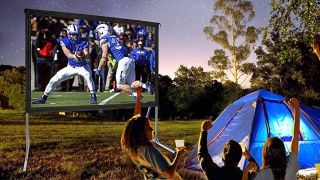Buying an outdoor projector? Here are the most important things to consider
If you're thinking of taking your games and entertainment outside this summer, then consider these key points

Nothing beats watching a great movie out under the stars, and the best outdoor projectors are a great way to keep your party or barbeque going on after the sun goes down. But if you’re thinking of investing in a projector for outdoor use, you might have a lot of questions about what makes a projector particularly good for outdoor usage, and what you need to consider ahead of investing.
In order to answer those questions, we’ve got all the key points you need to think about to help you decide on the best projector for what you need.
Screening surfaces
Getting one of the best outdoor projector screens or outright best projector screens is almost always going to be a necessity. The importance of this factor cannot be understated and that's why we have some top guides to help you out. However, in summary, the two key things to look for are gain and backing.
The key spec - where it's displayed; a lot of screens seem to not list this important factor - is gain. This is how well the light reflects back. The higher the gain, the brighter the image. Gain of over 1.0 means that the image coming off the screen is actually brighter than what is being projected onto it. High gain helps you to get the brightest picture you can.
Unless you want to use back projection (projecting onto the rear of the surface you’re watching) then it’s also worth investing in a screen with good backing. This prevents other light from coming through the screen, which would be competing with the light of your projector. You can also buy backing tape if you want to retrofit this onto a screen, but it’s usually better to have it built-in.

There are practical considerations as well – do you need a frame with your screen, can you leave the supports up permanently, does it need to be easily transportable, or, even, do you want an inflatable screen? This is going to depend on your space, and it’s worth looking at all your options to see what works best for you.
Location, location, location
Adjacent to screen selection, location is critical, and this has a lot of knock-on effects. Perhaps most important: will you have a fairly fixed place with access to a mains supply? If not, you’ll need a unit that runs off batteries.
Sign up to the 12DOVE Newsletter
Weekly digests, tales from the communities you love, and more
The main issue whenever you’re using a projector is other light sources, and if you’re watching outside, you’re competing with the biggest one of all. Direct sunlight around where you’re trying to project can cause real problems, draining colour and brightness from your image, even on some of the most premium and best 4K projectors. If you are planning to watch outside in the day you’ll need somewhere with a lot of shade. Having said all this, one of the best portable projectors like the BenQ GV1 or Epson EF-12 can get you out of a host of holes if you have space or options to move around.
Consider what the projector will rest on if you’ve got a fixed spot in mind. There’s plenty of outdoor furniture which would be perfect for positioning the projector. Or many portable projectors include a base to stand on a camera tripod.
If you’ve only got a short or narrow garden don’t let this put you off from getting a big picture. Short throw projectors like the BenQ TH671ST can give you a great picture from 3 to 8 feet (about one to three metres) depending on the unit. Standard projectors have a throw ratio of about 2.0 - for every two feet further away, the image size increases by a foot. Short throw ratios start around 0.7, so look for this kind of ratio if you have a small area to set up in.

Powering up
Being able to connect to mains electricity will mean you can choose from pretty much any home projector. However, some are better ready to be used outside due to their brightness and features which make them easier to set up in new places. There are a few projectors that are set up especially to be both portable but also requiring mains power. They might fill a slightly odd niche but if you’re looking for a home projector that you can easily take to different places there are some ideal options for you.
If you need a projector that runs from batteries then you have a smaller range of options - but still enough to choose from. These are often dimmer and best used after dark. Of course, battery life is a big factor here. It’s worth checking reviews, from users and professionals, to see how well the claims of manufacturers stand up, as well as checking whether longer battery life is at the expense of elements of performance – some will decrease their brightness level automatically when running off battery power. Generally, projector batteries will last for two to three hours, so enough time for most films, but you won't find the best projectors for PS5 and Xbox Series X running off batteries, for example, so for gaming, it might be better to look elsewhere.

Ease of set up
You won’t be leaving your projector outside constantly, so a quick setup is ideal. Many portable projectors offer automatic digital focus and auto keystone correction. Keystoning is making sure your image is rectangular. An automatic setup means you can get running quickly, without needing to make many manual changes.
Most portable projectors don’t have any image shift, and many don’t even have zoom controls, so the key to positioning the picture is the positioning of the projector itself. While some do have innovative ways to angle the image, like the Acer C250i, many just rely on adjustable feet which help to angle the unit. These are helpful to look for, otherwise, you could be wedging books or other items under the projector to get the right height and angles!
Making connections
The last few years have seen plenty of projectors being released with integrated operating systems. This doesn’t limit you to needing Wi-Fi – many will allow you to tether to your phone and use its data to stream or screen mirror. But be aware that many running versions of Android don’t have a number of key apps like Netflix approved for use, which generally seems to be an issue of the app makers refusing to licence them to the device. Alternatively, you can run media directly from a USB hard drive on most projectors.
Being Heard
If you’re watching outside you’re more likely to be using the built-in speakers than if you’re watching at home. As a result volume (and clarity of sound when the volume is turned up) is key here. Something like 5W speakers are usual for a home projector, and this can work outside if everything is quiet, but it’s not ideal and an external speaker is needed. Look out for units that have two 5W speakers, which will give good stereo sound, though. If you’re doing an outdoor cinema for the kids then it might have to be something which keeps their attention enough to stop them running around shouting but you’ll be able to hear without having the neighbours complain.

It's all about the light
As so much of this has been about light, it won’t surprise you that the brightness of the projector is also key. This is measured in lumens. As a rule for home projectors, 2,500 lumens is acceptable and 3,000 or higher is ideal for a room that gets a lot of light, aim for this level to get a viewable picture outside at dusk or with plenty of shade. You would need nearly fifty times that power to view in direct sunlight, and that simply isn’t likely to exist any time soon, so even the brightest projector won’t be any use out in the blazing sun.
It’s worth checking user reviews of projectors to see how well the claims of manufacturers, particularly at cheaper price points, stand up to scrutiny. Many Amazon reviews have photos from customers of their setups at different times of day which will help you to get an idea of what to expect.
With all these tips hopefully pointing you in the right direction, now’s the time to check out all our guides mentioned in this article so you can find the perfect units for you, and you can get ready for a whole summer of outdoor cinema enjoyment.
Will is a freelance writer for a number of publications including GamesRadar, where he covers hardware reviews - with projectors being a particular point of interest. Along with his work for GamesRadar, his words can be found in the Orlando Sentinel. He's also a professional wrestler, enjoys running, and playing guitar.
Most Popular
